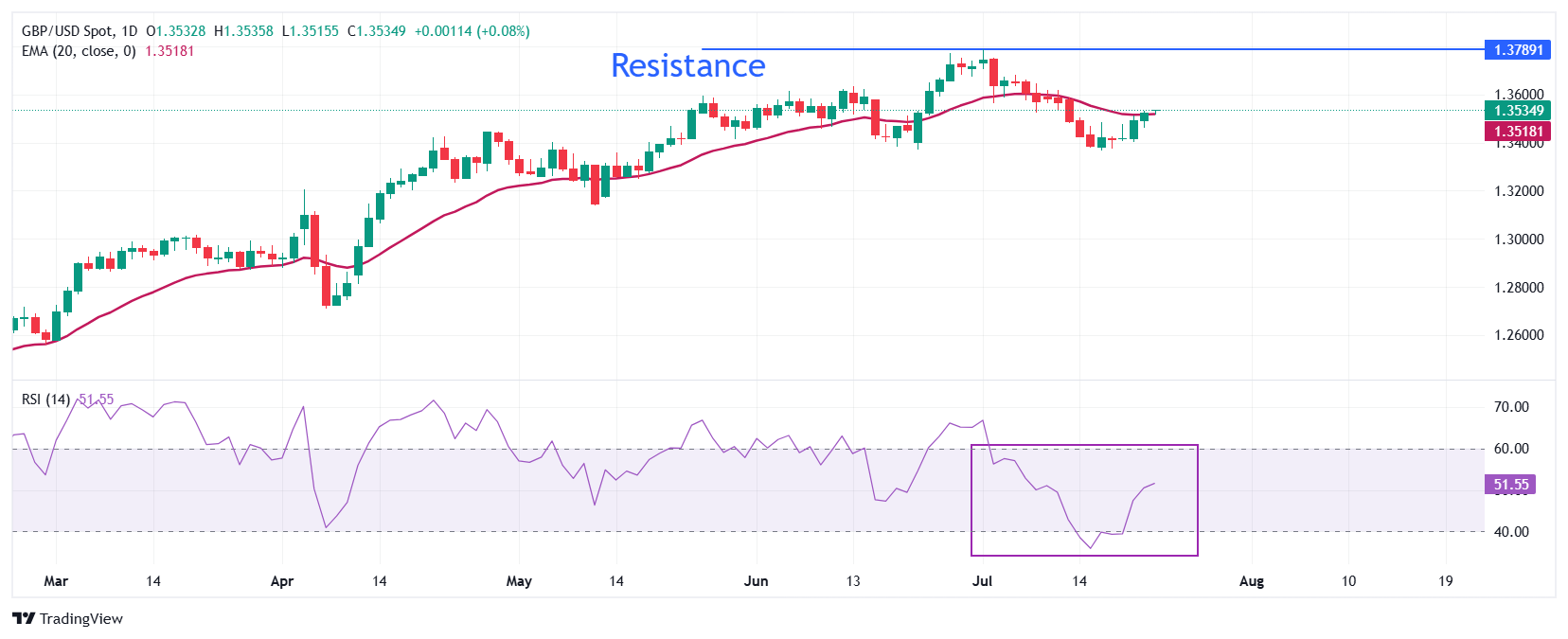Pound Sterling holds onto gains against USD despite US-Japan trade deal
- The Pound Sterling trades firmly against the US Dollar as investors ignore the US-Japan trade deal confirmation.
- Trump reduces tariffs on Japan to 15% from 25% previously announced.
- UK government borrowed second-highest amount of funds in June since 1993.
The Pound Sterling (GBP) clings to gains near 1.3520 against the US Dollar (USD) during the European trading session on Wednesday. The GBP/USD pair trades firmly as the US Dollar struggles to find ground even as Washington has confirmed a trade deal with Japan, which is one of its key trading partners.
The US Dollar Index (DXY), which tracks the Greenback’s value against six major currencies, trades around 97.45 at the time of writing, close to the two-week low at 97.30 posted on Tuesday.
US President Donald Trump stated through a post on Truth.Social on Tuesday that a trade agreement with Japan has been confirmed, according to which Washington will charge 15% tariffs on imports from Tokyo. Trump also stated that Japan will open its economy for US companies and will invest $550 billion.
“Japan will open their Country to Trade including Cars and Trucks, Rice and certain other Agricultural Products, and other things. Japan will pay Reciprocal Tariffs to the United States of 15%,” he wrote.
The trade deal between the US and Japan has come at a time when the Asia-Pacific giant is facing political risks, following an announcement from Japanese Prime Minister Shigeru Ishiba that he will step down by the end of August.
Meanwhile, Washington also closed a bilateral deal with the Philippines on Tuesday.
Daily digest market movers: Pound Sterling edges higher despite renewed UK fiscal risks
- The Pound Sterling ticks up against its peers, except antipodeans, with investors awaiting the release of preliminary S&P Global Purchasing Managers’ Index (PMI) data of July on Thursday.
- Investors will closely monitor the PMI data as it will indicate whether the hiring trend in the United Kingdom (UK) private sector is still sluggish. Private employers slowed down their hiring trend to offset the rising cost of social security schemes.
- Economists expect the Composite PMI to come in at 51.9 against 52.0 in June, suggesting that the overall business activity continued to expand, but at a moderate pace.
- Meanwhile, UK fiscal risks have resurfaced as the Office for National Statistics (ONS) reported on Tuesday that the government borrowed the second-highest amount of funds since 1993 in order to mitigate the increase in debt costs, which accelerated due to higher inflation. Mounting UK borrowings pave the way for tax increases by the administration in its upcoming Autumn Statement.
- On the monetary policy front, market experts are increasingly confident that the Bank of England (BoE) will cut interest rates at its August monetary policy meeting. Brokerage houses including Bank of America (BofA) Global Research, Citigroup, Morgan Stanley and Goldman Sachs have anticipated a 25 basis points (bps) interest rate reduction in the policy meeting next month.
- Going forward, the S&P Global will also publish flash US PMI data for July on Thursday. The US PMI is expected to have grown at a faster pace, driven by expansion in both the manufacturing and services sectors.
- Meanwhile, market expectations for the Federal Reserve (Fed) to reduce interest rates at the September meeting have diminished as experts believe that the impact of tariffs imposed by US President Trump has started feeding into prices.
- According to the CME FedWatch tool, the probability for the Fed to reduce borrowing rates at the September policy meeting has also reduced to 58.7% from 69.6% seen a month ago.
Technical Analysis: Pound Sterling aims to return above 20-day EMA

The Pound Sterling trades close to Tuesday’s high above 1.3500 against the US Dollar on Wednesday. The GBP/USD pair strives to return above the 20-day Exponential Moving Average (EMA) close to 1.3520. The near-term trend of the pair will turn bullish if it manages to do so.
The 14-day Relative Strength Index (RSI) rebounds to near 50.00, indicating indecision among investors and buying interest at lows.
Looking down, the May 12 low of 1.3140 will act as a key support zone. On the upside, the July 1 high around 1.3790 will act as a key barrier.
Pound Sterling FAQs
The Pound Sterling (GBP) is the oldest currency in the world (886 AD) and the official currency of the United Kingdom. It is the fourth most traded unit for foreign exchange (FX) in the world, accounting for 12% of all transactions, averaging $630 billion a day, according to 2022 data. Its key trading pairs are GBP/USD, also known as ‘Cable’, which accounts for 11% of FX, GBP/JPY, or the ‘Dragon’ as it is known by traders (3%), and EUR/GBP (2%). The Pound Sterling is issued by the Bank of England (BoE).
The single most important factor influencing the value of the Pound Sterling is monetary policy decided by the Bank of England. The BoE bases its decisions on whether it has achieved its primary goal of “price stability” – a steady inflation rate of around 2%. Its primary tool for achieving this is the adjustment of interest rates. When inflation is too high, the BoE will try to rein it in by raising interest rates, making it more expensive for people and businesses to access credit. This is generally positive for GBP, as higher interest rates make the UK a more attractive place for global investors to park their money. When inflation falls too low it is a sign economic growth is slowing. In this scenario, the BoE will consider lowering interest rates to cheapen credit so businesses will borrow more to invest in growth-generating projects.
Data releases gauge the health of the economy and can impact the value of the Pound Sterling. Indicators such as GDP, Manufacturing and Services PMIs, and employment can all influence the direction of the GBP. A strong economy is good for Sterling. Not only does it attract more foreign investment but it may encourage the BoE to put up interest rates, which will directly strengthen GBP. Otherwise, if economic data is weak, the Pound Sterling is likely to fall.
Another significant data release for the Pound Sterling is the Trade Balance. This indicator measures the difference between what a country earns from its exports and what it spends on imports over a given period. If a country produces highly sought-after exports, its currency will benefit purely from the extra demand created from foreign buyers seeking to purchase these goods. Therefore, a positive net Trade Balance strengthens a currency and vice versa for a negative balance.

